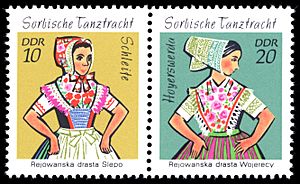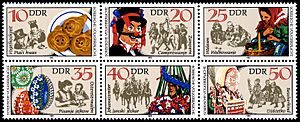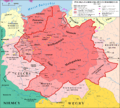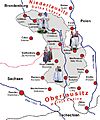Sorbs facts for kids

Sorbian flag, in Pan-Slavic colors, introduced in 1842
|
|

Traditional female costume of Lower Lusatia (Spreewald)
|
|
| Total population | |
|---|---|
| 60,000–80,000 (est.) • 45–60,000 Upper Sorbs • 15–20,000 Lower Sorbs |
|
| Regions with significant populations | |
| 60,000–80,000 | |
| 2,000 | |
| fewer than 1,000 | |
| Languages | |
| Sorbian (Upper Sorbian, Lower Sorbian), German | |
| Religion | |
| Majority Roman Catholicism, Lutheranism | |
| Related ethnic groups | |
| Other West Slavs (especially Silesians and Poles) |
|

The Sorbs is the world's smallest Slavic ethnic group. They live mostly in Germany and Poland. Today there are an estimated 60,000 Sorbs in Germany. A third live in the state of Brandenburg, where the Spreewald is located, and the rest live further south, in Saxony.
The Sorbs are descendants of Slavic tribes who lived north of the Carpathian Mountains in Central and Eastern Europe. Around 1,500 years ago, some of these tribes migrated to Lusatia, a historical region sometimes called Sorbia that straddled eastern Germany, western Poland and the northern tip of the Czech Republic.
Sorbs speak their own West Slavic languages: about 20,000 people in Saxony speak Upper Sorbian (which has similarities to Czech); while Brandenburg has around 5,000 speakers of Lower Sorbian (which has more in common with Polish). Both languages are endangered, and are protected and promoted locally.
Upper Sorbian and Lower Sorbian dialects are protected languages in parts of Germany under the European Charter for Minority or Regional Languages
In Germany and Poland Sorbs do not use the old fashioned words "Wends" or "Wendish" to describe themselves. American and Australian communities often prefer to call themselves "Wends" or "Wendish".
Etymology
The ethnonym "Sorbs" (Serbja, Serby) derives from the medieval ethnic groups called Sorbs (Surbi, Sorabi). The original ethnonym, Srbi, was retained by the Sorbs and Serbs in the Balkans. By the 6th century, Slavs occupied the area west of the Oder formerly inhabited by Germanic peoples. The Sorbs are first mentioned in the 6th or 7th century. In their languages, the other Slavs call them the "Lusatian Serbs", and the Sorbs call the Serbs "the south Sorbs". The name "Lusatia" was originally applied only to Lower Lusatia. It is generally considered that their ethnonym *Sŕbъ (plur. *Sŕby) originates from Proto-Slavic with an appellative meaning of a "family kinship" and "alliance", however others argue a derivation from Iranian-Sarmatian.
Traditions
A Shrove Tuesday festival Zapust is the most popular tradition of the Sorbs, deeply linked to the working life of the community. Traditionally, festivities would last one week ahead of the spring sowing of the fields and would feature traditional dress, parade and dancing.
Egg decorating (pisanici) is a Slavic Easter tradition maintained by Sorbs since the 17th century.
Cultural preservation
In 1904, mainly thanks to the Sorbs’ contribution, the most important Sorbian cultural centre (the Sorbian House) was built in Bautzen. In 1912, the social and cultural organization of Lusatian Sorbs was created, the Domowina Institution - the union of Sorbian organizations. In 1919 it had 180,000 members. In 1920, Jan Skala set up a Sorbian party and in 1925 in Berlin, Skala started Kulturwille- the newspaper for the protection of national minorities in Germany. In 1920, the Sokol Movement was founded (youth movement and gymnastic organization). From 1933 the Nazi party started to repress the Sorbs. At that time the Nazis also dissolved the Sokol Movement and began to combat every sign of Sorbian culture. In 1937, the activities of the Domowina Institution and other organizations were banned as anti-national. Sorbian clergymen and teachers were forcedly deported from Lusatia; Nazi German authorities confiscated the Sorbian House, other buildings and crops.
On May 10, 1945, in Crostwitz, after the Red Army’s invasion, the Domowina Institution renewed its activity. In 1948, the Landtag of Saxony passed an Act guaranteeing protection to Sorbian Lusatians; in 1949, Brandenburg resolved a similar law. Article 40 of the constitution of German Democratic Republic adopted on 7 October 1949 expressly provided for the protection of the language and culture of the Sorbs.
National symbols
The flag of the Lusatian Sorbs is a cloth of blue, red and white horizontal stripes. First used as a national symbol in 1842. In 1848, the flag was recognized among Sorbs. Section 25 of the Constitution of Brandenburg contains a provision on the Lusatian flag. Section 2 of the Constitution of Saxony contains a provision on the use of the coat of arms and traditional national colors of the Lusatian Sorbs. The laws on the rights of the Lusatian Sorbs of Brandenburg and Saxony contain provisions on the use of Lusatian national symbols (coat of arms and national colors).
The national anthem of Lusatian Sorbs since the 20th century is the song Rjana Łužica (Beautiful Lusatia). Previously, the songs “Still Sorbs Have Not Perished” (written by Handrij Zejler in 1840) and “Our Sorbs Rise from the Dust” (written by M. Domashka, performed until 1945) served as a hymn.
Images for kids
-
"House of the Sorbs" (Serbski dom) in Bautzen
-
Bautzen, German-Sorbian folk theatre
-
Bilingual names of streets in Cottbus
-
Lusatia was part of the Polish state between 1002 and 1031 under the rule of Bolesław I.
See also
 In Spanish: Sorbios para niños
In Spanish: Sorbios para niños
















